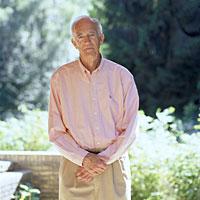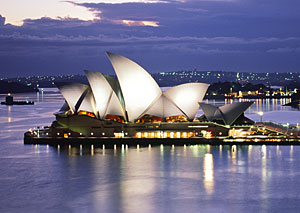 J'rn Utzon, designer of the Sydney Opera House, died November 28 at age 90. |
Jørn Utzon died November 28 at age 90, after a long illness. He never saw his masterpiece, the Sydney Opera House, completed. Though it is among the 20th-century’s most widely admired and audacious works, it is the architect’s great failure. It jump-started a promising career and stunted what should have been a glorious maturity.
Utzon married a great intuitive aesthetic to an almost heroic faith in the ability of technology to realize human aspiration. The son of a naval architect, Utzon was born in Copenhagen in 1918. Influenced by a cousin who was a sculptor, he entered the Copenhagen Royal Academy of Fine Arts, where he studied architecture. He graduated in 1942 and went on to work for Gunnar Asplund, and later, Alvar Aalto, before establishing his own practice in 1950.
Utzon had only built a few modest projects when he won the international competition for the Sydney Opera House in 1957 at the age of 38. His entry was so sketchy that even the required perspective view had not been included. He struggled for years (along with Arup, then a fledgling engineering firm) to find a way to build the hall’s famous sail-form roofs. The shapes of the shells he had designed could not be analyzed by the engineering tools available at the time. His Eureka moment was realizing that he could carve triangles that looked like little Opera House roof shapes out of the spherical shape of an orange. These geometries retained the intended lyricism of the design while being vastly easier to engineer and build. That metaphor became legendary as evidence of his extraordinary ability to tease elegantly synthetic solutions out of the most unlikely sources.

In 1965, his struggle to design the auditorium interiors proved just as difficult; every iteration involved sacrificing sightlines, or acoustics, or the desired seat count. The way the wind blows sand into thin, overlapping layers suggested to him that the ceiling could be made of similar striations, each molded with notches and gentle curves to the unique angle and strength of sound they would receive.
But those ceilings were never to be. A new government had been elected, and the new minister in charge of the project was impatient with the cost overruns and endless delays. In a dispute, the minister claimed Utzon quit, while Utzon declared that he had been fired. He left Australia in 1966, never to return. A team of three architects finished the Sydney Opera House in 1973 at a cost of $102 million (Australian), more than double the last estimate during Utzon’s tenure.
Because of the Sydney scandal, Utzon was blackballed in his home country of Denmark. Two of his projects had the earmarks of greatness: a theater in Zurich, and an intricate complex for the Kuwait National Assembly. Zurich, after nine years, was abandoned. In Kuwait officials steadily pared back the architect’s expression of democratic aspiration. The bowdlerized result, completed in 1982, was later severely damaged by fire and rebuilt unsympathetically.
The most celebrated of his later works is the 1976 Bagsvaerd Church, in Denmark. A dignified rectilinear exterior encloses a surprisingly joyous, sensuous ribbon of ceiling within. Another project, Can Lis, a house built in 1973 by Utzon for his own family, was admired for its extraordinary serenity. It is a series of modest pavilions hewn from local stone on a stunning clifftop site in Majorca.
As the years passed, the shortcomings of the Sydney Opera House auditoriums became more obvious, and a consensus gathered that Utzon had been done an injustice. In 1999, Sydney officials appointed Utzon to conceive design principles that would guide an upgrade of the building. Utzon was awarded the Pritzker Prize in 2003 in part because of the Sydney rapprochement.
Suffering illness, Utzon worked with his son, Jan, from Denmark on the renovation plan. Reported to cost as much as $800 million (Australian), the plan has not been released. Its future is uncertain.



Post a comment to this article
Report Abusive Comment